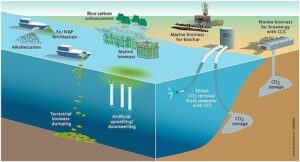The release of CO2 to the atmosphere has become a problem. So much so, that a nonsensical idea like direct air capture (DAC) has attained followers. And is even experimented on by companies. Clearly, the world is in distress when an extreme idea like direct air capture can be taken seriously.

The stakes are high
Our attention to the serious consideration given to DAC was drawn by an article by David Austgen in Biofuels Digest. It’s a dangerous idea, he argues. Green-washing at its very worst. If DAC is taken seriously by policy makers and the general public, this will lend the oil and gas companies delay in reducing their levels of production. Allowing them to continue their profitable business for a longer time. The stakes are high!
Oil and gas companies are investing in direct air capture because ‘to the average person it sounds like a fantastic solution to climate change’. It comes with the promise of a breakthrough solution – and one that involves almost no pain. The oil majors invest in it ‘because they know most people will welcome the concept but will not understand its limitations’. Well, that is to say, people who don’t understand the laws of thermodynamics. For capturing CO2 from a very dilute source like ambient air is about the most inefficient pathway imaginable. Rather, we should capture CO2 from flue gases, where its concentration is 10 to 1000 times higher. Or still better, not capture CO2 at all, but invest heavily in technologies that will prevent CO2 production, like solar and wind energy. Or let us plant trees, they also remove CO2. And if we should capture CO2, let’s not store it but use it!

Direct air capture: inefficient
‘From an economic perspective, it (direct air capture) is the most inefficient investment in CO2 abatement,’ writes Augsten. ‘But the oil and gas companies do not need to invest significant sums to keep their licenses to operate. They just need to sell the Promise they can remove CO2 directly from the air.’ Therefore, we need to speak out against DAC. The only goal of the oil majors is to keep up production for another decade. And then?
Given this state of affairs, it is surprising to see how much support there is for this weird concept. For instance, in 2020 the World Economic Forum devoted a positive article to this technology. They concede that this is ‘not a solution to prevent global warming on its own’ (anyone said so?). As one of the CEOs involved puts it: ‘it is imperative (…) that we develop and deploy all of the tools at our disposal’. Including the nonsensical ones?
A ’comprehensive strategy’
Wikipedia takes the obvious neutral position, but still notes: ‘DAC also requires much greater energy input in comparison to traditional capture from point sources, like flue gas, due to the low concentration of CO2’. And: ‘The use of any fossil-fuel-generated electricity would end up releasing more CO2 to the atmosphere than it would capture.’
Nevertheless, the International Energy Agency finds that ‘DAC is a key part of the carbon removal portfolio’. For it is part ‘of a comprehensive strategy for ‘net’ zero – where emissions being released are ultimately balanced with emissions removed.’ Yes, there are ‘nature-based solutions such as afforestation’. But ‘DAC with geological CO2 storage has several advantages as a CDR approach, including a relatively small land and water footprint, and high degree of assurance in both the permanence of the storage and the quantification of CO2 removed.’ But what about the efficiency of such a scheme?
Towards real solutions
In short, the idea of direct air capture has a major following. Enough to let several companies experiment with a clearly nonsensical technology. Let’s embark on serious technological solutions quickly, in order to remove any cause for daydreaming. Renewable technologies. They don’t release of CO2 to the atmosphere – therefore, no need to remove it. And if we should capture CO2: let’s capture it where concentrations are high; and use it, not store it.
Interesting? Then also read:
CCU, Carbon Capture and Utilization, even better than biomass as a feedstock
RMI: decarbonize fast and profitably
Methane pyrolysis turns a grey resource into a green one
